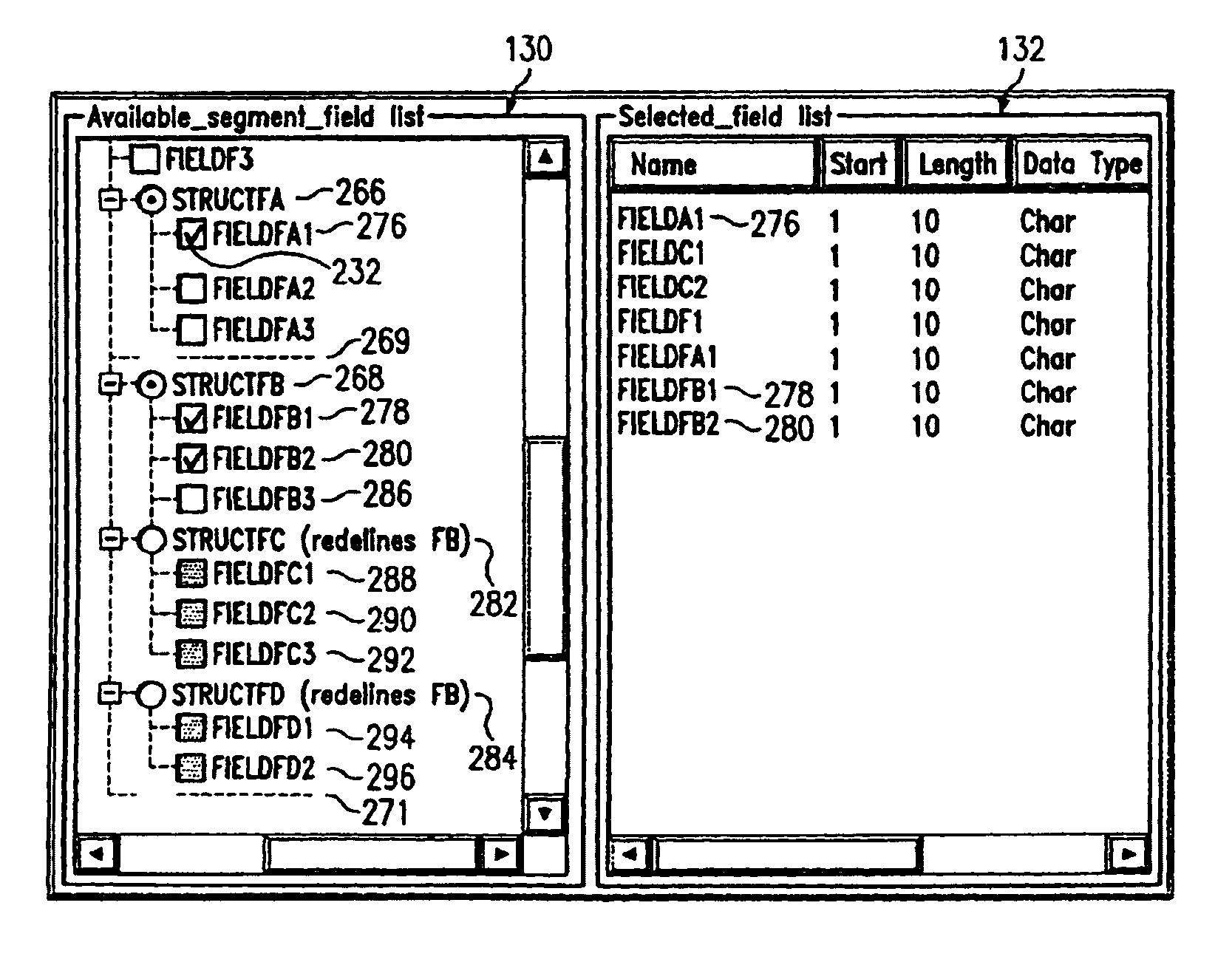[0010]An embodiment of the present invention relates to systems, methods, and computer products that efficiently share and move data between different types of data storage formats. More particularly, the preferred embodiment of the present invention provides an easy to use
graphical user interface (GUI) for displaying, navigating, and selecting segments and fields of a hierarchical database or data files and for identifying mutual exclusivity between the segments and fields. One embodiment of the present invention parses the PSBs, DBDs, and
programming language data structures and displays the overlapping data structures represented in a hierarchical
tree view of available segments and fields. The hierarchical
tree view may be expanded or collapsed. The preferred embodiment of the present invention enables users to select segments and fields that are associated with a valid path in the hierarchical
tree view and to view invalid paths. Alternatively the preferred embodiment of the present invention may automatically select fields that are associated with the valid path in the hierarchical tree view and indicate invalid paths. A database segment typically represents the smallest amount of data that may be transferred by a database operation. A field is a portion of a segment that is typically the smallest unit of data that may be referred to by hierarchical database operations.
[0011]The preferred embodiment of the present invention novelly uses a
tree structure that clearly represents the structures of a database or a file, for easy understanding of and navigation through the various data structures. Further, the preferred embodiment of the present invention efficiently maps information typically associated with a
relational database into a hierarchical
tree structure. It is quite difficult to select the appropriate fields in a hierarchical tree structure that are associated with the most efficient path through the many levels of the hierarchical tree structure thereby enabling path efficient navigation of the hierarchical tree structure. According to the preferred embodiment of the present invention, the efficient path is represented by a
list of fields that may include information about the field such as: the field name, the
data type, the location of the field, and the length of the field. The preferred embodiment of the present invention enables quick and efficient navigation of such a path in a tree hierarchy that typically includes thousands of fields in hundreds of segments that are many
layers deep. The appropriate fields are therefore identified and mapped to information in a relational database that is typically located in columns of a table associated with the relational database.
[0012]In the preferred embodiment of the present invention selected segments within a
list of segments will be represented with both their relationship and alignment to other segments, and their mutual exclusivity relative to other segments and fields clearly identified. This enables efficient and accurate navigation of a valid path through the hierarchical structure associated with large amounts of data.
[0013]Also, the user may select a full path from the top of the hierarchical tree, the root, to a specific segment or field. The user is prevented from selecting segments and fields that are mutually exclusive and therefore not valid for the selected path thereby ensuring accuracy in the representation of the data structures. In the preferred embodiment of the present invention, when the user selects the last, or bottom, segment in a hierarchical representation of segments the full path is concisely selected for the user thereby quickly enabling the user to access the full path without having to navigate the path.
[0014]Further, the definitions of the fields in various data structures are represented thereby enabling a user to select the segments and fields to be used during database and
file system operations, from a variety of data structures. For example and in one embodiment of the present invention,
programming language data structures located in data files are represented along with segments and fields thereby enabling the user to select data elements from either the
programming language data structures, or segments and fields. In the preferred embodiment of the present invention the
programming language data structures, such as
COBOL copybook structures, may include redefinitions of the structures, and these redefined structures are presented to the user to ensure that all possible data is available and properly encoded. Further, this allows the user to choose a more meaningful
data structure name, such as a
COBOL copybook name, than the name defined in the database.
[0015]In one embodiment of the present invention computer-represented radio buttons associated with segments enable efficient movement of associated fields, such as
insertion and removal of the fields, with respect to a selected or de-selected
list of data segments. In one embodiment of the present invention, computer-represented boxes may be checked thereby identifying selected fields and computer-represented radio buttons may be highlighted thereby identifying selected segments. In the preferred embodiment of the present invention computer-based
data operations retain information about the previous state of selections of radio buttons and boxes thereby enabling efficient exploration of alternative
data structure representation.
 Login to View More
Login to View More  Login to View More
Login to View More 


